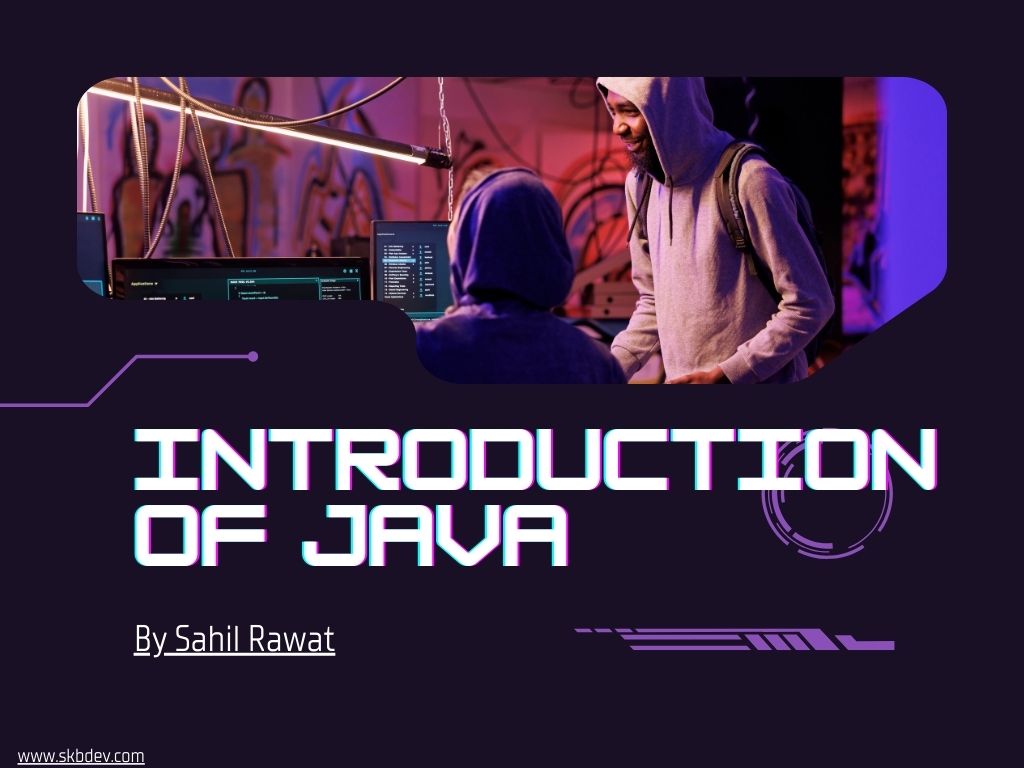Introduction to Java – Java is a versatile and powerful programming language widely used in web development. Known for its platform independence, robust libraries, and security features, Java has become a cornerstone for building scalable and dynamic websites. Whether you’re starting your journey as a web developer or looking to expand your skills, this article will introduce you to Java’s role in web development and how it empowers the creation of high-performing websites.
What is Java?
Java is an object-oriented programming language developed by Sun Microsystems (now owned by Oracle) in 1995. It is designed to be “write once, run anywhere” (WORA), meaning Java code can run on any device equipped with the Java Virtual Machine (JVM). Its simplicity, security, and scalability make it ideal for creating enterprise-level web applications.

Introduction to Java hello
Why Use Java for Web Development?
Java has established itself as a leading choice for web development. Here’s why:
1. Platform Independence
Java applications are compiled into bytecode that can run on any JVM, regardless of the underlying hardware or operating system.
2. Scalability
Java is perfect for both small-scale and enterprise-level web applications. Its robust frameworks and tools support horizontal and vertical scaling.
3. Security
Built-in security features like authentication, encryption, and role-based access control ensure the safety of web applications.
4. Rich Ecosystem
Java offers an extensive ecosystem of frameworks and tools like Spring, Hibernate, and Apache Struts, which streamline web development.
5. Community Support
A large and active developer community ensures continuous updates, support, and innovations.
Introduction to java Java frameworks Java frameworks for websites
Java for Web Development
Java’s web development capabilities are powered by various tools and technologies:
1. Java Servlets
Servlets are Java programs that run on a server, handling client requests and responses dynamically.
2. JavaServer Pages (JSP)
JSP enables developers to embed Java code within HTML for dynamic content generation.
Introduction to Java
3. Frameworks
- Spring Framework: Offers a comprehensive set of features for building enterprise-level web applications.
- Hibernate: Simplifies database interactions using an object-relational mapping (ORM) approach.
- Apache Struts: Facilitates the development of Model-View-Controller (MVC) based applications.
4. Java APIs
APIs like Java Database Connectivity (JDBC) and Java Persistence API (JPA) simplify database operations.
Getting Started with Java for Web Development
Step 1: Set Up Your Environment
- Install Java Development Kit (JDK): Download and install the latest JDK from Oracle’s official website.
- Choose an IDE: Use an Integrated Development Environment (IDE) like IntelliJ IDEA, Eclipse, or NetBeans for efficient coding.
Introduction to Java
Step 2: Learn the Basics
Familiarize yourself with:
- Core Java concepts like OOP, data structures, and multithreading.
- Java-specific web technologies like Servlets and JSP.
Step 3: Explore Frameworks
Dive into popular frameworks like Spring and Hibernate to build advanced web applications.
Step 4: Deploy Your Application
Use servers like Apache Tomcat, WildFly, or GlassFish to deploy and manage your Java web applications.
Best Practices for Java Web Development
- Follow MVC Architecture: Organize your application into Model, View, and Controller layers for better maintainability.
- Optimize for Security: Implement robust authentication mechanisms and secure sensitive data.
- Use Version Control: Leverage tools like Git to manage your codebase efficiently.
- Test Thoroughly: Use testing frameworks like JUnit for unit testing and Selenium for UI testing.
Java in Action: Real-World Applications
Many leading organizations and websites rely on Java for web development. Examples include:
- LinkedIn: Uses Java for scalability and high-performance back-end operations.
- Amazon: Relies on Java frameworks to handle complex e-commerce functionalities.
- Spotify: Implements Java for its robust recommendation system.
Conclusion
Java’s versatility, reliability, and extensive ecosystem make it a top choice for web development. Whether you’re building a simple website or a complex enterprise application, Java provides the tools and frameworks needed to succeed. Start your journey today, and unlock the potential of Java for crafting dynamic and secure websites.
Introduction to Java
FAQs
Q: Can Java be used for front-end development?
A: While Java is primarily used for back-end development, frameworks like JavaFX and Vaadin enable some front-end capabilities.
Q: Is Java suitable for small websites?
A: Yes, Java is scalable and can efficiently power both small and large websites.
Q: What is the best framework for Java web development?
A: The choice depends on your needs, but Spring Boot is popular for its ease of use and versatility.
By optimizing your Java skills and leveraging its robust frameworks, you can create websites that are not just functional but also scalable and secure. Ready to get started?

